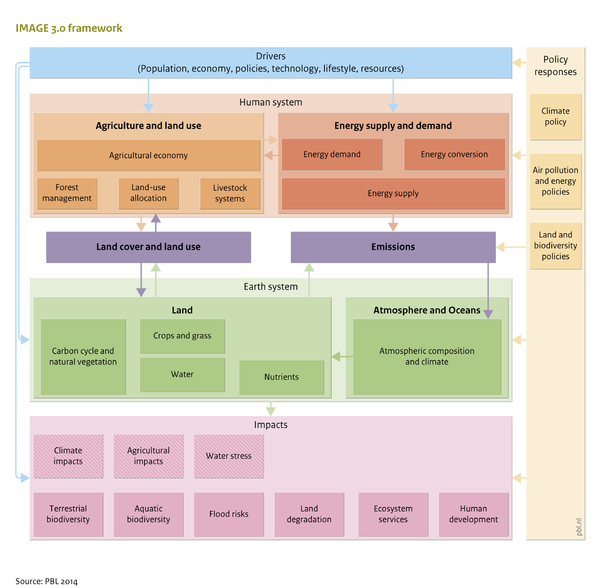IMAGE framework summary: Difference between revisions
Jump to navigation
Jump to search
No edit summary |
Oostenrijr (talk | contribs) No edit summary |
||
| (7 intermediate revisions by 2 users not shown) | |||
| Line 1: | Line 1: | ||
{{FrameworkSummaryTemplate | {{FrameworkSummaryTemplate | ||
|ComponentCode=IF | |ComponentCode=IF | ||
|Overview=Framework overview; | |Overview=Framework overview; Policy interventions and components overview; Key policy issues overview; | ||
|KeyReference=Stehfest et al., 2014; | |Application=Roads from Rio+20 (2012) project; | ||
|KeyReference=Stehfest et al., 2014; PBL, 2012; | |||
}} | }} | ||
<div class="page_standard"> | |||
Integrated assessment models, such as the IMAGE framework, are established as powerful tools in assessing complex, large-scale environmental and sustainable development issues. As many of these issues are closely interlinked, integrated models are needed to analyse the consequences of these linkages, and the substantial inertia in the human-environment system can only be captured in long-term scenarios. Here, an overview of the IMAGE framework and its use in assessing long-term environmental and human future is presented. | |||
{{DisplayFigureLeftOptimalTemplate|IMAGE framework schematic}}</div> | |||
Latest revision as of 19:19, 10 March 2020
| Projects/Applications |
| Relevant overviews |
| Key publications |
Key policy issues
- How could global environmental issues such as climate change, biodiversity loss and air pollution evolve?
- What are the consequences of these changes for international targets for biodiversity protection (addressed by the CBD), climate change (UNFCCC) and human development (addressed by the Millennium Development Goals and Sustainable Development Goals)?
- How could response strategies limit environmental pressures and foster more sustainable development?
- What are the linkages between components of environmental change and human development? What are key uncertainties?
Introduction
Integrated assessment models, such as the IMAGE framework, are established as powerful tools in assessing complex, large-scale environmental and sustainable development issues. As many of these issues are closely interlinked, integrated models are needed to analyse the consequences of these linkages, and the substantial inertia in the human-environment system can only be captured in long-term scenarios. Here, an overview of the IMAGE framework and its use in assessing long-term environmental and human future is presented.
